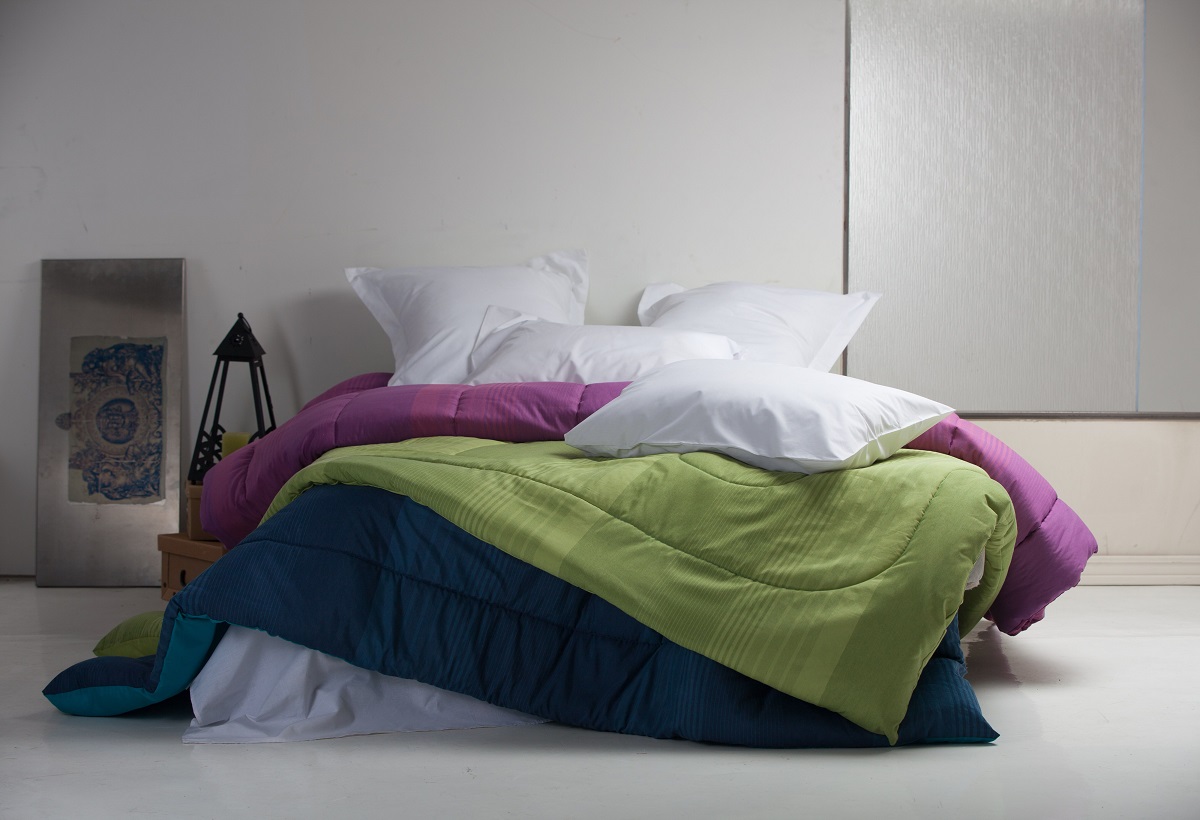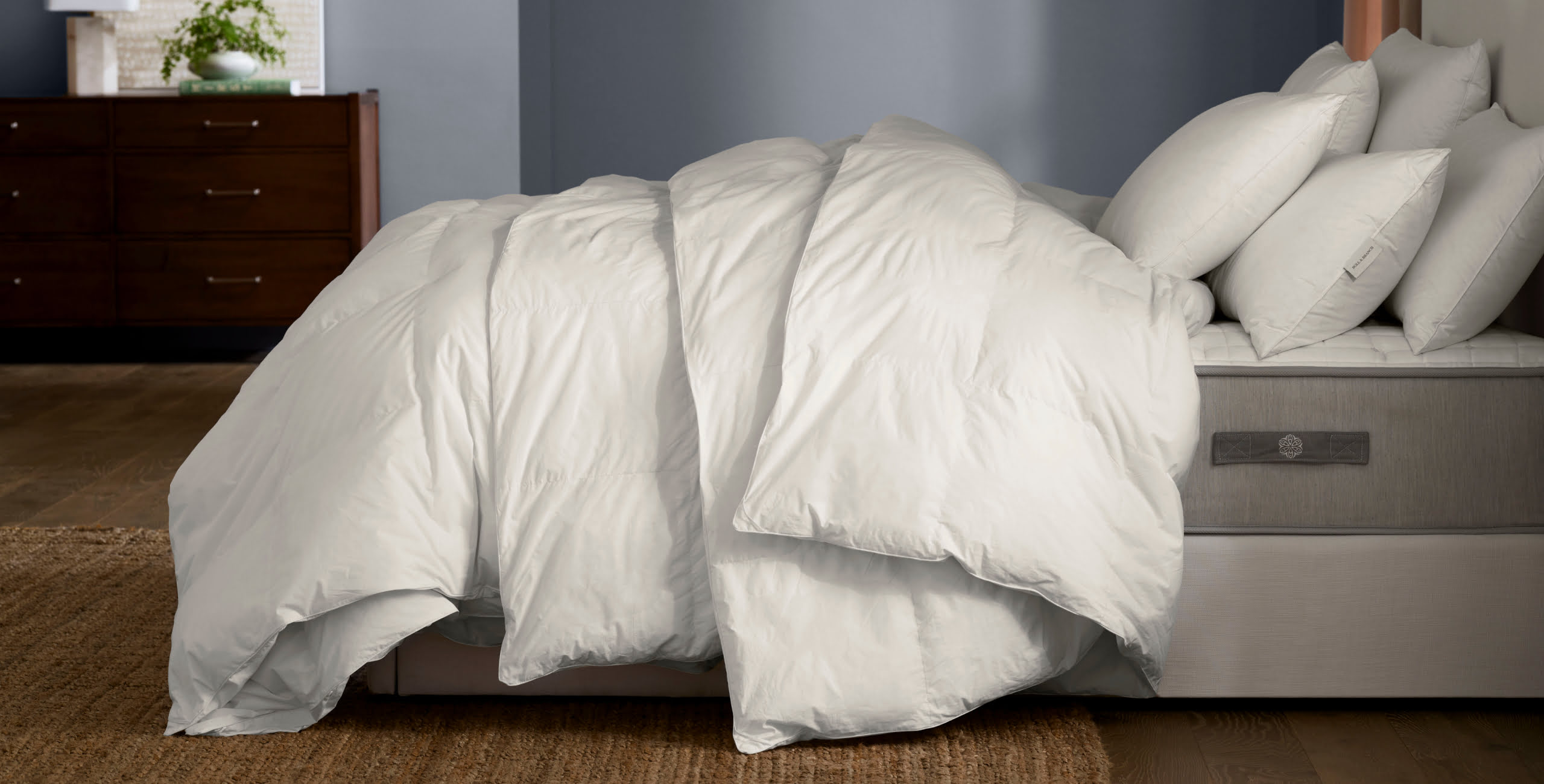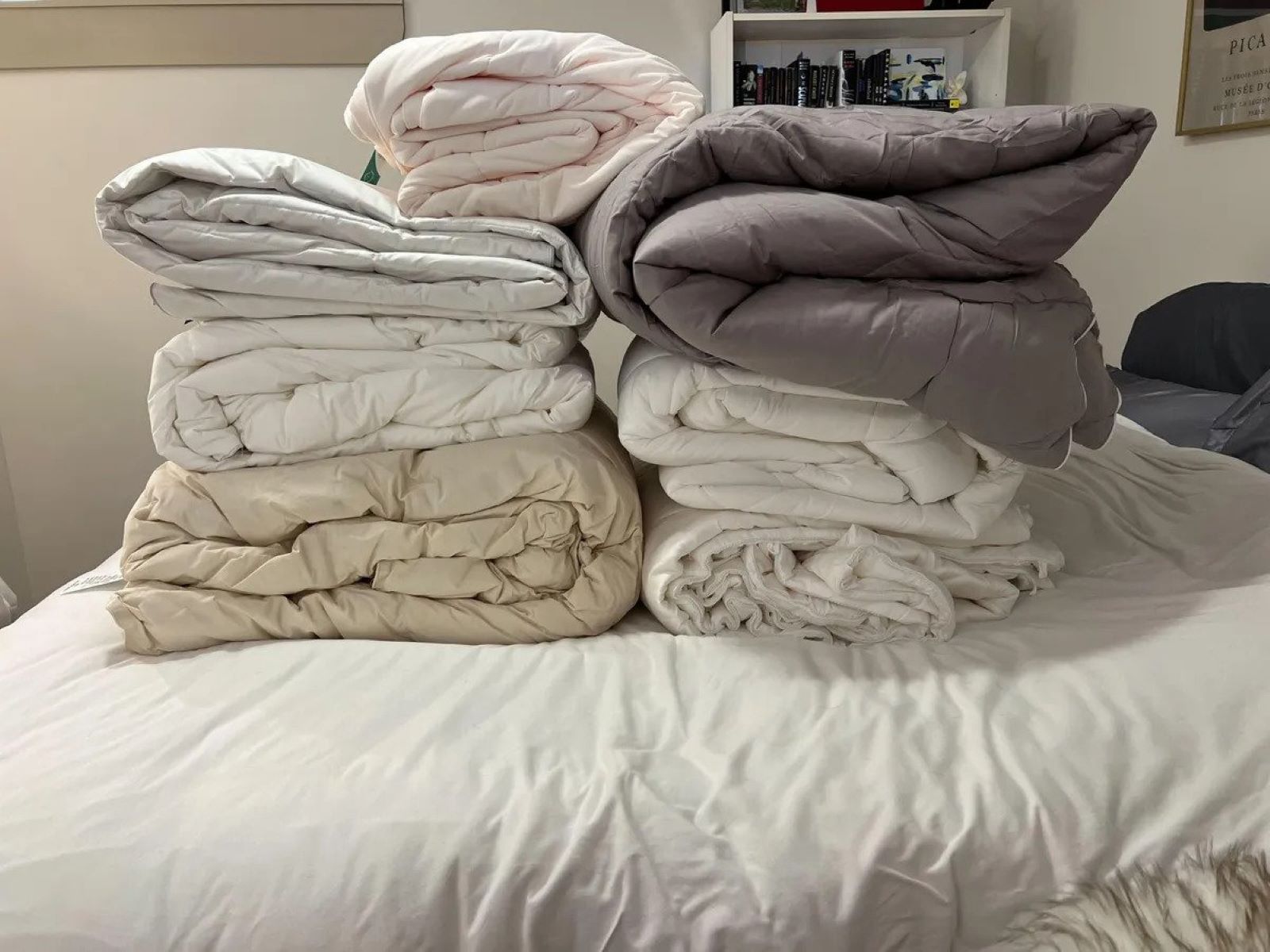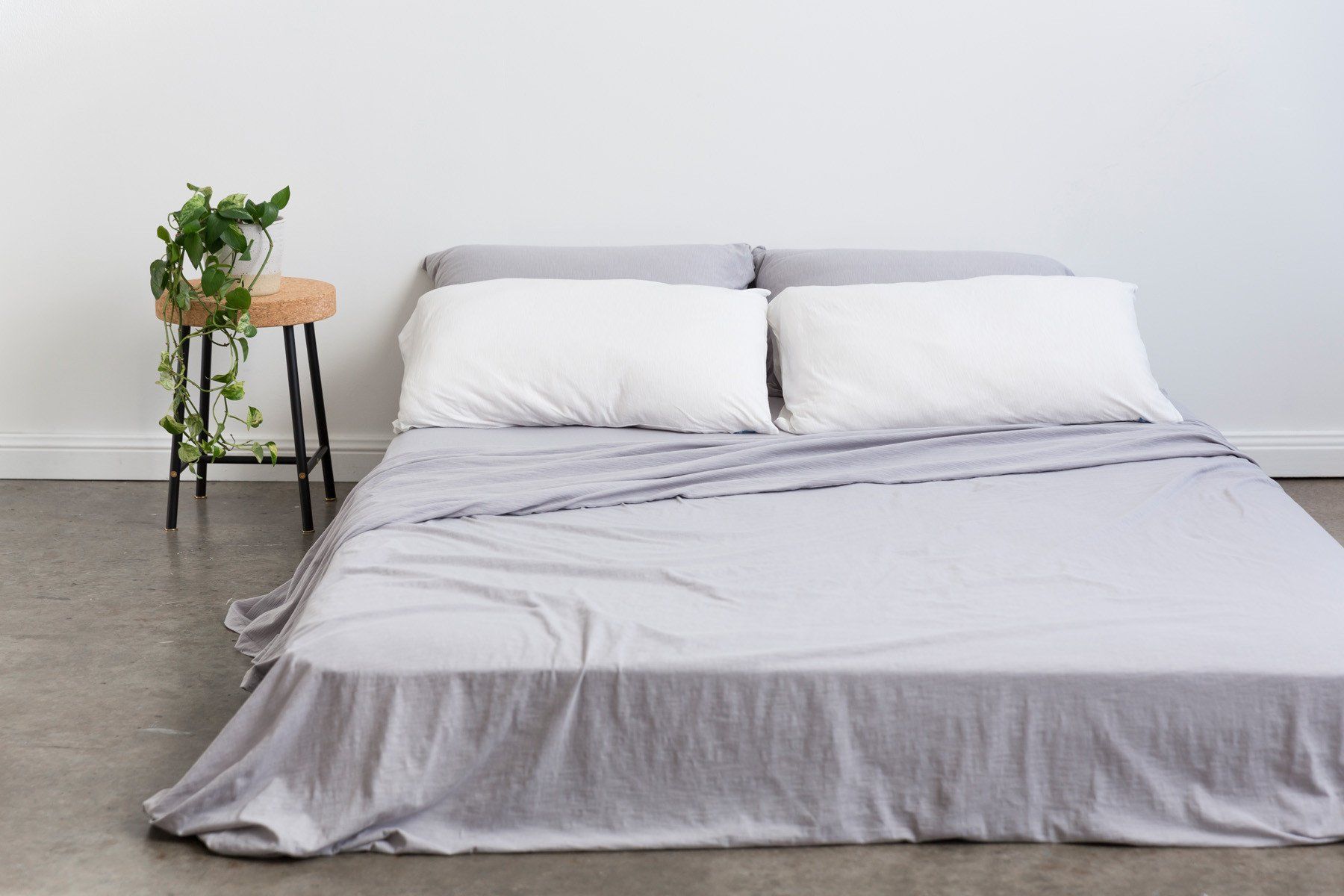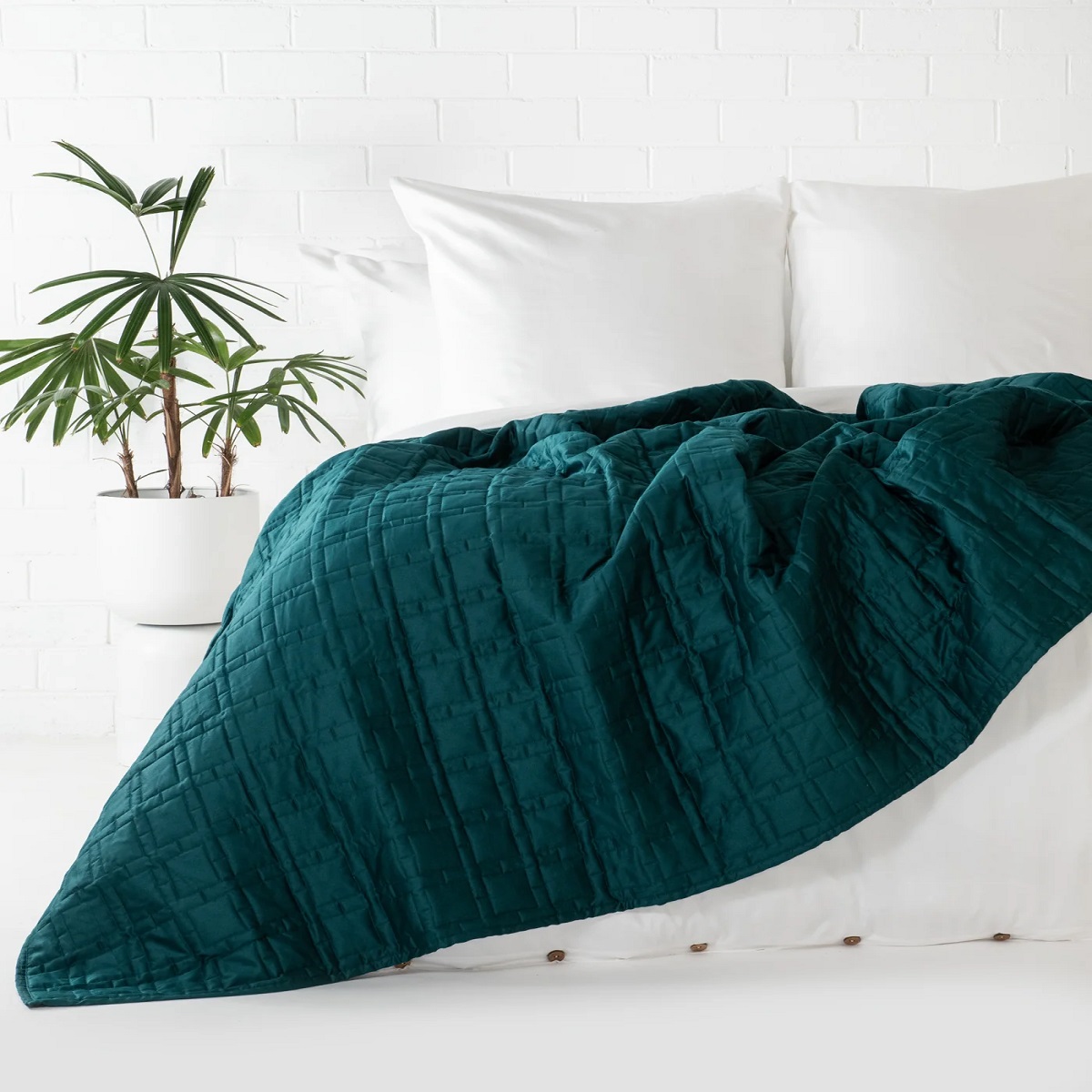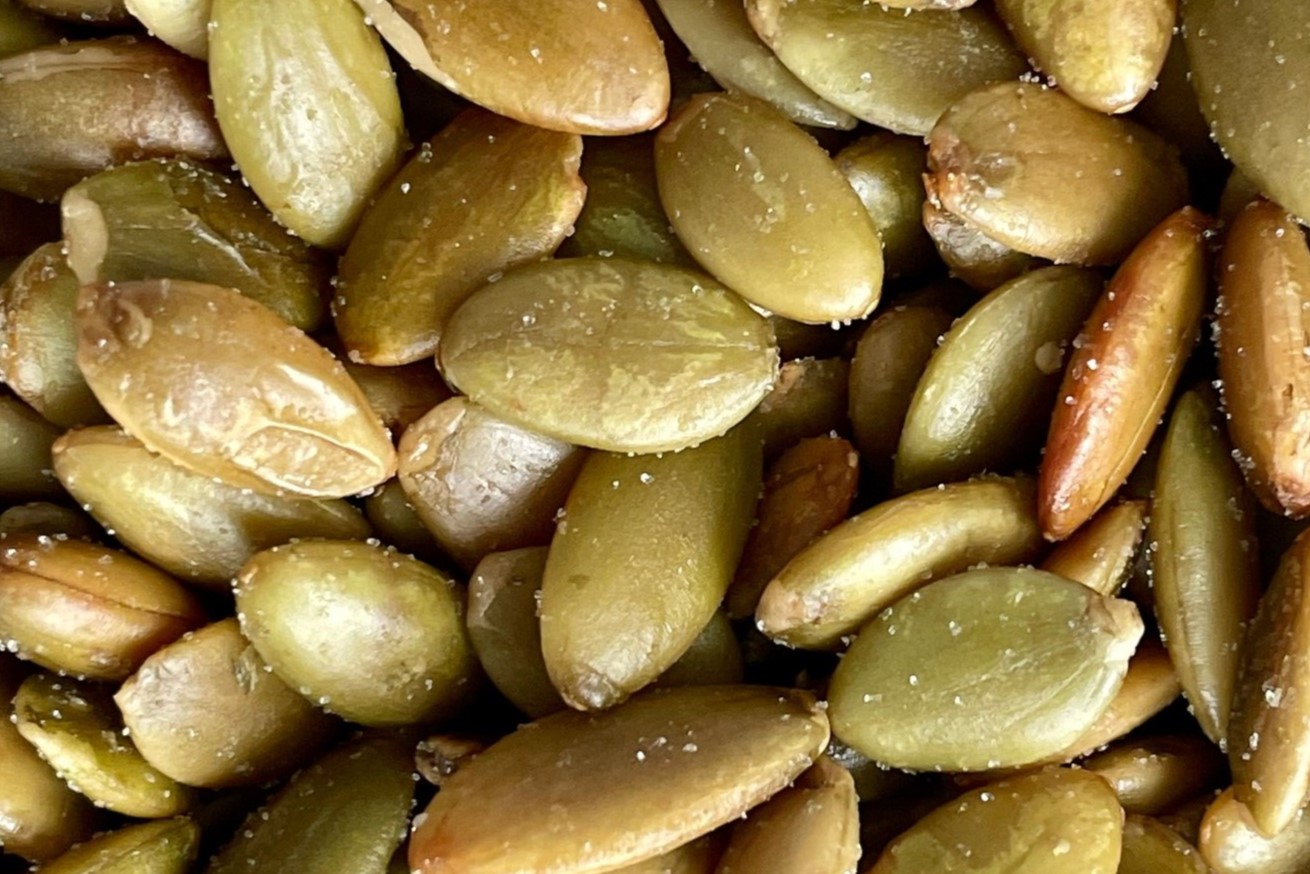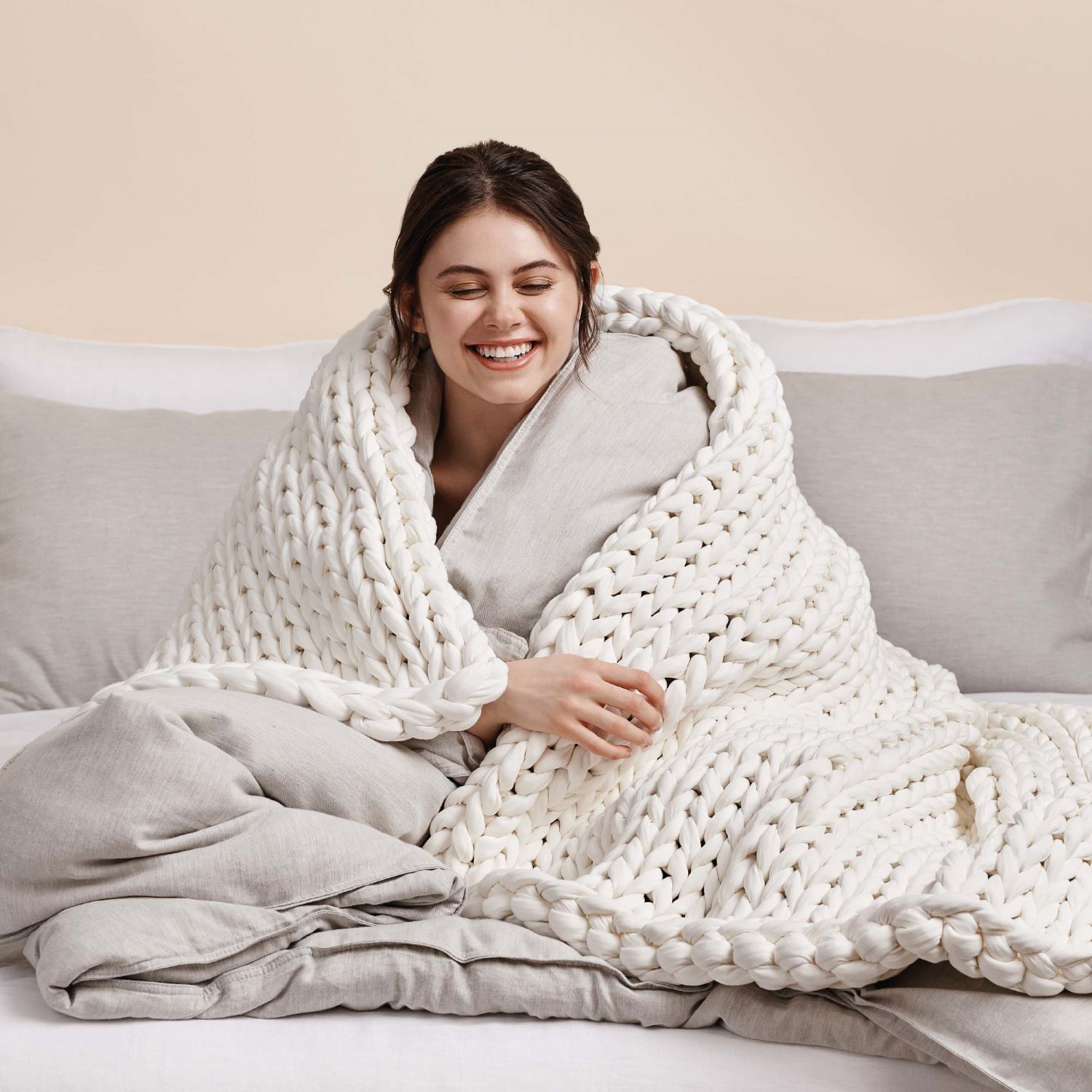

Articles
Blanket Vs. Comforter: What’s The Difference?
Modified: October 20, 2024
Discover the key differences between comforters and blankets with our insightful articles. Find out which one is the perfect choice for your bedding needs.
(Many of the links in this article redirect to a specific reviewed product. Your purchase of these products through affiliate links helps to generate commission for Storables.com, at no extra cost. Learn more)
Introduction
A cozy bed is essential for a good night’s sleep, and one of the key elements in achieving this is choosing the right bedding. When it comes to keeping warm and comfortable, comforters and blankets are two popular options. While they may appear similar at first glance, there are actually significant differences between the two. In this article, we will explore the definitions of comforters and blankets, examine their materials and construction, discuss the benefits of each, and help you decide which option is best for your needs.
A comforter is a thick, quilted bed cover that is filled with synthetic fibers, down feathers, or a combination of both. It is designed to provide warmth and insulation during colder months. Comforters are typically larger in size than blankets, covering the entire mattress and draping over the sides.
A blanket, on the other hand, is a lighter and more versatile bedding option. It is usually made from a single layer of fabric, such as cotton, fleece, or wool. Blankets come in various sizes, from small throws to larger ones that can cover the entire bed.
Now that we have a basic understanding of what comforters and blankets are, let’s delve deeper into their material and construction to better understand their differences.
Key Takeaways:
- Comforters provide exceptional warmth and insulation, making them ideal for colder climates and those seeking a cozy, enveloping sleep experience. Their larger size and various designs enhance both comfort and bedroom aesthetics.
- Blankets offer versatility and lighter weight options, suitable for milder climates, warmer seasons, or individuals preferring a less bulky covering. With a variety of sizes and fabrics, blankets cater to diverse comfort preferences and usage beyond the bed.
Definition of a Comforter
A comforter is a thick, quilted bed cover that is designed to provide warmth and insulation. It is typically filled with synthetic fibers, down feathers, or a combination of both. The filling is evenly distributed throughout the comforter, ensuring consistent insulation across the entire surface. The outer shell of a comforter is made from a durable fabric, such as cotton or polyester, which helps to contain the fill and protect it from wear and tear.
Comforters come in various weights, ranging from lightweight options suitable for warmer climates to heavier ones for colder weather. The weight of a comforter is often measured in terms of its fill power, which refers to the amount of space one ounce of filling occupies. Higher fill power indicates a higher quality comforter with better insulation properties.
One of the distinguishing features of a comforter is its quilted construction. This refers to the stitching pattern that holds the fill in place. The most common quilt patterns are channel stitching and box stitching. Channel stitching creates long, narrow compartments that run the length of the comforter, while box stitching forms square compartments. Both patterns help prevent the fill from shifting, ensuring that the comforter maintains an even distribution of warmth throughout the night.
Comforters are available in a wide range of designs, colors, and patterns, making it easy to find one that matches your personal style and bedroom decor. Some comforters also come with matching pillow shams or pillowcases, allowing you to create a coordinated and visually appealing bedding ensemble.
Overall, comforters are a popular bedding choice for those seeking warmth, comfort, and style. Their thick and quilted construction, along with a variety of filling options and designs, make them a versatile and cozy addition to any bedroom.
Definition of a Blanket
A blanket is a versatile and lightweight bedding option that provides warmth and comfort. Unlike a comforter, which is designed to cover the entire mattress, a blanket is typically smaller in size and can be used for various purposes beyond the bed. It is made from a single layer of fabric, such as cotton, fleece, or wool.
Blankets come in a variety of sizes, from small throws that are perfect for snuggling on the couch to larger ones that can cover the entire bed. The size you choose depends on your personal preference and the intended use of the blanket.
The construction of a blanket may vary depending on the fabric and style. For example, cotton blankets are often woven or knit, creating a breathable and lightweight feel. Fleece blankets are made from synthetic materials and have a soft and plush texture. Wool blankets, on the other hand, are known for their exceptional insulation properties and durability.
Blankets are a versatile bedding option that can be used in multiple ways. They can be layered on top of a sheet for added warmth during cooler nights, used as a throw blanket for extra comfort while lounging, or even taken outdoors for picnics or camping trips.
In addition to their practical uses, blankets also come in a wide range of designs, colors, and patterns. This allows you to choose a blanket that suits your personal style and complements your bedroom decor.
One important factor to consider when selecting a blanket is its weight. Some blankets are lightweight and breathable, making them ideal for use in warmer seasons or climates. Others are thicker and provide more insulation, making them perfect for colder weather. It’s important to choose a blanket with the right weight to ensure optimal comfort and temperature regulation.
Overall, blankets are a versatile and essential bedding option that offers comfort, warmth, and style. Their lightweight and varied construction make them suitable for a wide range of uses, making them a must-have in any home.
Material and Construction of Comforter
The material and construction of a comforter play crucial roles in determining its warmth, durability, and overall quality. Let’s explore the common materials and construction methods used in comforters:
Filling Materials: Comforters are typically filled with synthetic fibers, down feathers, or a combination of both.
- Synthetic fibers: Synthetic fillings, such as polyester or microfiber, are hypoallergenic, affordable, and easier to maintain. They offer warmth and insulation comparable to natural down feathers.
- Down feathers: Down comforters are filled with the soft clusters found underneath the outer feathers of ducks or geese. Down is known for its exceptional insulation and fluffy texture, providing a cozy and luxurious sleeping experience.
- Down alternative: For those who prefer animal-free products, down alternative comforters are filled with synthetic fibers designed to mimic the warmth and loft of natural down.
Outer Shell: The outer shell of a comforter is typically made from cotton or polyester fabric.
- Cotton: Cotton is a natural, breathable material that provides comfort and durability. It is hypoallergenic and suitable for individuals with sensitivities or allergies.
- Polyester: Polyester is a synthetic fabric that is easy to care for and resistant to wrinkles. It is more affordable compared to cotton but may not offer the same breathability.
Quilting Patterns: Comforters are quilted to keep the filling evenly distributed and prevent shifting.
- Channel stitching: This quilting pattern creates long, narrow compartments, or channels, throughout the comforter. It helps to maintain an even distribution of filling, providing consistent warmth across the entire comforter.
- Box stitching: Box stitching involves sewing square compartments, or boxes, to hold the filling. This pattern prevents the fill from shifting, ensuring a uniform loft and insulation.
Baffle-box construction: Some high-quality comforters feature baffle-box construction. This technique involves sewing vertical strips of fabric between the top and bottom layer of the comforter. This creates three-dimensional compartments that keep the filling in place, eliminating cold spots and ensuring optimal warmth and insulation.
When selecting a comforter, consider factors such as fill material, outer fabric, and quilting pattern to find a comforter that suits your preferences and needs. The material and construction of a comforter greatly impact its comfort, durability, and overall performance, making it essential to choose one that aligns with your desired level of warmth and quality.
Material and Construction of Blanket
The material and construction of a blanket play a significant role in its comfort, warmth, and durability. Let’s explore the common materials and construction methods used in blankets:
Fabric Types: Blankets can be made from various materials, each offering unique qualities and benefits.
- Cotton: Cotton is a natural and breathable fabric that is soft, durable, and suitable for all seasons. It provides comfort and ensures proper airflow, preventing excessive heat retention.
- Fleece: Fleece is a synthetic fabric known for its softness, warmth, and lightweight feel. It provides excellent insulation, making it ideal for colder weather.
- Wool: Wool blankets are made from natural animal fibers and are highly prized for their exceptional insulation properties. They are warm, moisture-wicking, and durable.
- Acrylic: Acrylic blankets are synthetic, lightweight, and affordable. They mimic the softness and warmth of wool while being easier to care for and less prone to allergens.
Construction Techniques: The construction of a blanket affects its weight, thickness, and overall comfort.
- Woven: Woven blankets are created by interlacing threads over and under each other using a loom. This construction method produces a durable and tightly woven fabric with a structured feel.
- Knit: Knitted blankets are made by interlooping yarns using knitting needles or machines. This construction provides a stretchy and cozy texture, perfect for snuggling up.
- Quilted: Some blankets feature a quilted construction, which involves stitching together multiple layers of fabric with a layer of padding in between. This method creates a structured and warm blanket with a quilted pattern.
Weight and Thickness: Blankets come in various weights and thicknesses, providing options for different seasons and personal preferences.
- Lightweight: Lightweight blankets are ideal for warmer climates or as a supplemental layer during mild weather. They are breathable and offer a slight warmth without causing overheating.
- Medium-weight: Medium-weight blankets strike a balance between warmth and breathability. They are versatile and suitable for moderate temperatures.
- Heavyweight: Heavyweight blankets provide exceptional warmth and insulation, making them perfect for colder climates or those who prefer a cozy and snug feeling.
When choosing a blanket, consider factors such as the fabric type, construction technique, and weight to find one that suits your needs and preferences. The material and construction of a blanket significantly impact its comfort, insulation, and durability, making it important to select one that provides the desired level of warmth and quality.
Read more: Juicer vs Blender: What’s The Difference?
Benefits of Using a Comforter
Comforters offer numerous benefits that contribute to a comfortable and cozy sleeping experience. Let’s explore some of the advantages of using a comforter:
1. Warmth and Insulation: Comforters are specifically designed to provide warmth and insulation, making them ideal for colder nights and colder climates. The thick layers of filling, whether synthetic or down feathers, trap and retain body heat, keeping you comfortably warm throughout the night.
2. Versatility: Comforters are available in various weights and fillings, allowing you to choose the one that suits your preferences and seasonal needs. They can be used year-round, as lightweight comforters are suitable for warmer seasons, while heavier comforters provide additional warmth during colder periods.
3. Softness and Comfort: Comforters are often made from soft and luxurious fabrics, such as cotton or microfiber. Their plush textures provide a cozy and comfortable feel against the skin, allowing you to relax and unwind as you drift off to sleep.
4. Aesthetically Pleasing: Comforters come in a wide range of designs, colors, and patterns, making them a stylish and decorative addition to your bedroom. They can enhance the ambiance and visual appeal of your space, adding a touch of personality and warmth to your bed.
5. Easy Maintenance: Comforters are generally easy to care for. Most can be machine washed and dried, making cleaning and maintenance a breeze. Regularly washing your comforter helps to maintain its freshness and extend its lifespan.
6. Allergy-Friendly Options: For individuals with allergies or sensitivities, there are hypoallergenic comforters available. These are designed to minimize the presence of allergens, such as dust mites and pet dander, ensuring a more comfortable and allergy-free sleep environment.
7. Complete Coverage: Comforters are larger in size compared to blankets, providing full coverage for your mattress. This extra coverage extends over the sides of the bed, preventing any drafts or cold spots and creating a more encompassing and snug sleeping experience.
8. Durability: Comforters are generally well-constructed and made to withstand regular use. They are designed to be sturdy and long-lasting, ensuring you can enjoy their comfort and warmth for years to come.
Overall, comforters offer a range of benefits that contribute to a comfortable, cozy, and visually pleasing bedroom environment. Their warmth, versatility, softness, and ease of maintenance make them a popular choice for individuals seeking a comfortable and inviting bed.
When choosing between a comforter and a blanket, consider the level of warmth and insulation you need. Comforters are typically thicker and provide more warmth, while blankets are lighter and more versatile for layering.
Benefits of Using a Blanket
Blankets offer a multitude of benefits, ranging from warmth and comfort to versatility and style. Let’s explore some of the advantages of using a blanket:
1. Warmth and Comfort: Blankets are designed to provide warmth, making them essential for snuggling up and staying cozy during colder seasons or in chilly environments. They offer an extra layer of insulation, helping to trap and retain body heat for a comfortable night’s sleep.
2. Versatility: Blankets are incredibly versatile and can be used in various settings and situations. They can be draped over your bed as an extra layer of warmth, used as a throw blanket on sofas or chairs for added comfort, or even taken outdoors for picnics or camping trips.
3. Breathability: Depending on the fabric used, blankets can provide breathability and allow for proper airflow. Natural materials like cotton or wool are known for their breathability, preventing overheating and ensuring a comfortable sleeping environment.
4. Lighter Weight: Compared to comforters, blankets are generally lighter in weight. This makes them a suitable option for those who prefer a less bulky covering or for use in warmer climates where a heavy comforter might be too warm.
5. Easy Maintenance: Blankets are typically easy to care for and maintain. Most can be machine washed and dried, saving you time and effort in cleaning. Their simplicity in maintenance ensures that your blanket remains fresh and usable for years.
6. Style and Decor: Blankets come in a wide variety of colors, patterns, and designs, allowing you to add a touch of style and personality to your bedroom or living space. They can serve as a decorative accent, complementing your existing decor and enhancing the visual appeal of the room.
7. All-Season Use: Depending on the weight and fabric, blankets can be used throughout the year. Lightweight blankets are suitable for warmer seasons, while heavier ones offer added warmth during colder months. This versatility allows you to adapt to changing weather conditions without needing to switch out your bedding.
8. Affordability: Blankets often come at a more affordable price point compared to comforters or other bedding options. This makes them accessible and a budget-friendly choice for those looking to add an extra layer of coziness to their bedding ensemble.
As you can see, blankets offer a range of benefits, from providing warmth and comfort to adding style and versatility to your living space. Their lightweight nature, ease of maintenance, and affordability make them a practical and essential bedding accessory for any home.
Differences in Insulation
One significant difference between comforters and blankets lies in their insulation capabilities. Let’s explore the variations in insulation between the two:
Comforters:
Comforters are specifically designed to offer optimal warmth and insulation. They typically have a thicker and more substantial construction compared to blankets, allowing them to provide a higher level of insulation. The filling materials used in comforters, such as synthetic fibers or down feathers, are excellent insulators that trap and retain body heat, keeping you cozy throughout the night.
The quilted stitching patterns in comforters, such as channel stitching or box stitching, help maintain the even distribution of filling, ensuring consistent warmth. The substantial thickness and loftiness of comforters create a layer of insulation that effectively retains heat and shields you from cold drafts.
Blankets:
While blankets do provide some level of insulation, they generally have a lighter weight and thinner construction compared to comforters. Blankets offer a more moderate level of warmth and are suitable for milder climates or as an additional layer in combination with other bedding.
The insulation capabilities of blankets vary depending on the fabric used. Natural materials such as wool or densely woven cotton can provide superior insulation due to their inherent properties, while synthetic fabrics like fleece may offer less insulation but provide softness and warmth.
Blankets are designed to provide a balance between warmth and breathability. They allow for air circulation, preventing overheating and ensuring a comfortable sleep environment. Blankets are a great option for individuals who prefer a lighter covering or need flexibility in layering bedding according to fluctuating temperatures.
Ultimately, the insulation provided by comforters and blankets differs in terms of thickness, filling materials, and construction. Comforters excel in offering higher levels of warmth and are specifically designed for insulation during colder seasons. Blankets, on the other hand, provide a moderate level of warmth and breathable insulation suitable for various climates and personal comfort preferences.
Differences in Size and Covering
When comparing comforters and blankets, one notable difference lies in their size and coverage. Let’s explore the variations in size and covering between the two:
Size:
Comforters are typically larger in size compared to blankets. They are designed to cover the entire mattress and drape over the sides, providing a more encompassing and luxurious look. The generous dimensions of comforters ensure that they can fully cover and protect your bed, offering a cozy and visually pleasing aesthetic.
On the other hand, blankets come in a range of sizes, from small throws to larger sizes that can cover the entire bed. The size of the blanket you choose depends on your personal preference and the intended use. Throws can be used for snuggling on the couch or as an extra layer of warmth, while larger blankets are suitable for cuddling up in bed or spreading out for picnics or outdoor activities.
Covering:
Comforters and blankets also differ in terms of their covering or outer fabric. The covering of a comforter is typically made from a durable fabric, such as cotton or polyester. These materials provide protection for the filling, prevent it from shifting, and enhance the comforter’s overall durability.
Blankets, on the other hand, offer more variety in their covering materials. They can be made from a range of fabrics including cotton, fleece, wool, or synthetic materials like acrylic. Each fabric type offers different textures, levels of softness, and breathability to cater to diverse preferences and intended uses.
The differences in size and covering between comforters and blankets provide distinct features and options to suit individual needs and preferences. Comforters offer a larger coverage area, giving a luxurious and complete look to the bed. Blankets, on the other hand, come in various sizes and offer greater flexibility in terms of usage, from personal snuggling to outdoor activities. The difference in covering materials allows for a variety of textures and breathability options to cater to different comfort requirements.
Read more: Rattan vs Wicker: What’s The Difference?
Choosing Between a Comforter or Blanket
When it comes to selecting between a comforter and a blanket, several factors need to be considered to ensure you make the right choice for your needs and preferences. Let’s explore these factors to help you make an informed decision:
Climate and Season:
Consider the climate you live in and the seasons you will be using the bedding for. If you reside in a colder climate or experience cold winters, a comforter may be the ideal choice. Comforters provide thicker insulation, allowing for more warmth during colder months. For milder climates or warmer seasons, blankets offer a lightweight option that provides a comfortable level of warmth without overheating.
Personal Preferences:
Take into account your personal preferences for bedding. If you enjoy the feeling of a heavier covering and a more encompassing sleep experience, a comforter may be the preferred choice. Comforters offer a cozy and plush feel, providing ample warmth and a luxurious look. However, if you prefer a lighter and more versatile option, blankets offer flexibility and can be used for various purposes beyond the bed.
Bed Size:
Consider the size of your bed when choosing between a comforter and a blanket. Comforters are designed to cover the entire mattress and drape over the sides, providing an elegant and complete look. If you have a larger bed or prefer a more generous coverage, a comforter is a suitable choice. Blankets come in a range of sizes, from small throws to larger sizes that can cover the bed. Consider the size of your bed and how much coverage you desire to make the right selection.
Care and Maintenance:
Consider your preferences for cleaning and maintenance. Comforters may require more careful washing due to their larger size and thicker construction. Some comforters may also require professional cleaning. On the other hand, blankets are often easier to care for and can be machine washed and dried more conveniently. Assess your willingness and ability to accommodate the care requirements of each option.
Style and Decor:
Consider the aesthetic appeal you want to achieve in your bedroom. Both comforters and blankets come in various designs, patterns, and colors, allowing you to select one that complements your bedroom decor. Take into account the visual impact you desire to create and choose the bedding option that aligns with your style preferences.
By considering climate, personal preferences, bed size, care requirements, and style, you can make an informed decision when choosing between a comforter and a blanket. Ultimately, the choice boils down to your individual needs and the specific attributes that matter most to you in terms of comfort, functionality, and visual appeal.
Conclusion
When it comes to selecting the right bedding for your sleep needs, both comforters and blankets have their own unique advantages. Understanding the differences in their insulation, size, covering, and other factors will help you make an informed decision.
Comforters are designed to provide exceptional warmth and insulation, making them an excellent choice for colder climates or individuals who prefer a cozy and enveloping sleep experience. With their larger size, they offer complete coverage for the bed and come in various designs to enhance your bedroom’s aesthetic appeal.
On the other hand, blankets offer versatility and a lighter weight option. They are ideal for milder climates, warmer seasons, or individuals who prefer a less bulky covering. Blankets come in a variety of sizes and fabrics, providing choices to suit different preferences and intended uses beyond the bed.
When choosing between a comforter and a blanket, consider factors such as climate, personal comfort preferences, bed size, care requirements, and style. By assessing these factors, you can find the ideal bedding option that meets your specific needs and enhances your overall sleep experience.
Remember, there are no right or wrong choices when it comes to comforters and blankets. Your decision should be based on individual preferences and the level of warmth, coverage, versatility, and style that you desire in your bedding. Whether you opt for the enveloping warmth of a comforter or the lightweight flexibility of a blanket, both options will provide you with the comfort and coziness necessary for a restful night’s sleep.
Investing in high-quality bedding that suits your needs will ensure that you can enjoy a comfortable, warm, and inviting sleep environment for years to come.
Frequently Asked Questions about Blanket Vs. Comforter: What's The Difference?
Was this page helpful?
At Storables.com, we guarantee accurate and reliable information. Our content, validated by Expert Board Contributors, is crafted following stringent Editorial Policies. We're committed to providing you with well-researched, expert-backed insights for all your informational needs.


